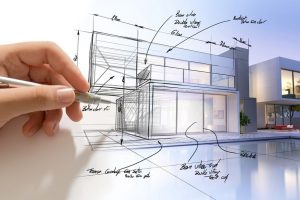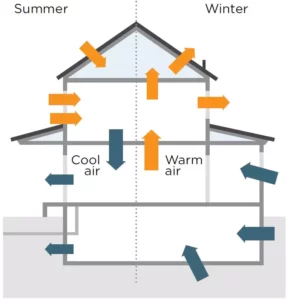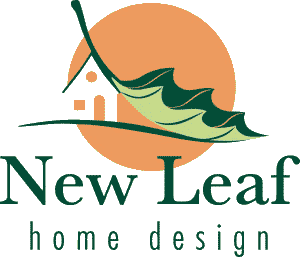At New Leaf, I’ve been working with several people on new home designs, in addition to my usual renovation projects. So I thought I’d share my thoughts about new home design, and what makes a new home project a good fit for New Leaf.
When I tell people about what I do, they often seem a little surprised that most of my projects are addition and renovation designs rather than new homes. Many people think that only big, elaborate projects warrant having an architect. It’s true that most architectural firms focus more on commercial and large residential work, but the projects I’ve done for more than 20 years provide plenty of evidence that smaller projects go more smoothly and turn out better with an architect’s help. So why does New Leaf choose to do more addition and renovation projects than new homes? What makes a new home project a good fit for New Leaf? Is working with an architect on a new house an all or nothing decision? Actually, understanding why I work on so many existing homes can help you understand the kinds of new home projects I enjoy the most. Here are the three basic considerations:
The charm of old houses
First and foremost, I love older homes. I like their craftsmanship, their detailing, and their neighborhoods. I’ve lived in a little 1925 Italian Renaissance house, a big 1930 Colonial Revival, and now my 1959 ranch. I like to find ways to keep these older homes working for us by giving them better Kitchens, more closet space, and more open floor plans. I also enjoy taking the language established by the rest of the house and continuing it so that the new areas look like they belong with the original parts of the house. For houses that don’t have a lot of character to start with, a renovation is an opportunity to create some special features: an archway, a window seat, or perhaps a beautifully crafted front porch for example.
In the original drawings for many older houses, you can see that the designers took the time to create drawings showing what the interior detailing should look like: built in book cases, wainscoting under the stairs, fireplace mantles. For new homes, I enjoy creating details that give this kind of character. This is true for any style of house, from Craftsman to Modern. The important thing is to take the time to think about what the finished space is going to look like, understand how the rooms are going to relate to each other, and design the details that will give each space a unique character.
Every renovation project is unique
The second reason I do so many additions and renovations is that each renovation project is totally unique. There are lots of stock plans out there for new homes, and since you are sharing the design cost for that plan with hundreds, or even thousands of other home buyers, these plans are bound to be more economical than a custom design. This isn’t an option for a renovation. You can’t buy a stock plan for a breakfast room addition, or to add a Master Suite over your garage, so you need an architect or designer to come up with a solution that works for your particular house.
For many people building a new home, stock plans are a good economical option. You can even make a few changes to the plan so it fits your needs better. If they are simple changes, a draftsman may be your best choice. Many stock plan companies offer modification services, or you can find someone locally to work with. You will need to purchase the drawings from the plan company in order to have copyright permission to use the design for your project, but once you have purchased the copyright release you are free to make whatever changes you want.
However, even if you are purchasing a stock plan, a few hours of advice from an architect can get you a better house. I recently had a client come to me with a stock plan that he wanted to adjust. Wali and I met and 
looked over the design he had been considering, and I asked whether they really wanted to have both a Breakfast area and a formal Dining Room. Since construction costs were a concern, it didn’t make sense to build space that they didn’t need. As a result, he looked over some more plans online and found a similar plan without a separate Dining Room. Like the first plan, this one included an attached Garage, so it still needed some modifications. I put together a sketch showing how the plan would work without the Garage. This process was more efficient and economical than creating a completely custom design from scratch, but I was able to provide some personalized advice and design in a way that couldn’t be duplicated over the Internet.
Quality over Quantity
The third reason I haven’t done more new houses is that until recently, many of the people who approached architects for new home designs have been interested in big houses of 4000 square feet or more, and I’m just not that interested in designing those. In the last few years though, there 
is increasing appreciation for new homes that are smaller while still feeling spacious and fitting their owners’ lifestyles, and are more energy efficient. It’s much more difficult to find stock plans that do these things well, and these are challenges I really enjoy solving!
Most stock plans aren’t yet detailed to provide the amount of insulation and air sealing needed for real energy efficiency for our climate. As a native Ohioan, I didn’t always realize that most of the country is warmer than northeast Ohio. That means that a house designed for the “average” climate in the U.S. isn’t a good fit for our region. And if you want walls that can accommodate above-average amounts of insulation, the wall thicknesses and details in a typical stock plan just won’t work.
Also, a home intended to make the most of every square foot needs to consider the site where it will be built. If you can create a beautiful view for the Dining area by placing it on the right side of the house, you will never miss having a two-story Foyer. Finding a stock plan that is sensitive to all of the site features, from lot size to views, can be nearly impossible. And of course, sustainable design means that you need to consider where the sun is coming from so you can design for passive heating, natural lighting, and possible solar panel systems. This kind of careful design customized for your family and the site where you will be building will take more time, and therefore a little more of your construction budget will need to be allocated toward design services. But good design can mean that you build only the space you need, you get more accurate estimates from contractors, construction goes more smoothly, and you save on energy bills every year that you live in your new home. Plus, you get a design that is comfortable, beautiful and enjoyable to live in.
Just as I create a new design for each of my projects, I also customize the services I provide to fit each of my clients’ needs. So if you are thinking about building a new home, give me a call and I’ll help you decide what level of architectural services are the best fit for you and your family.
